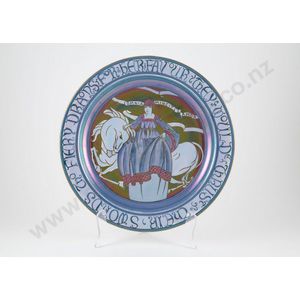Gloria Charger by Susie Cooper, 1924
A. E. Gray & Co. Ltd Gloria pattern charger lustre ware design by Susie Cooper circa 1924 'Tho Fiery Draons for her Favour They Would Thrust their Swords', 31 cm diameter printed marks
You must be a subscriber, and be logged in to view price and dealer details.
Subscribe Now to view actual auction price for this item
When you subscribe, you have the option of setting the currency in which to display prices to $Au, $US, $NZ or Stg.
This item has been sold, and the description, image and price are for reference purposes only.
- Circa - A Latin term meaning 'about', often used in the antique trade to give an approximate date for the piece, usually considered to be five years on either side of the circa year. Thus, circa 1900 means the piece was made about 1900, probably between 1895 and 1905. The expression is sometimes abbreviated to c.1900.
- Lustre Ware - Ceramics that have been coated with metallic oxides and then fired, to give a metallic finish, using a similar technique to, and sometimes resembling the irridescent finish on glass. Colours produced included silver (using platinum), gold, pink, white, copper and cream. Lustre ware was first made in England in the late 18th century. In the 19th century, many Staffordshire potteries produced lustre ware including Crown Devon, Royal Worcester, Carlton Ware, and Wedgwood. A lustre glaze was used very successfully by Belleek, in Country Fermanagh, Ireland. Many of their wares displayed a nautical theme including shell shapes, dolphins, and mer-boys.
- Charger - An oversize dish or plate in ceramic, silver, or pewter primarily made for display, but able to be used for serving at the table or on a sideboard.
- Lustre Ware - Lustre decoration on ceramics is created by painting a thin deposit of metal oxide such as gold, silver or copper onto the surface, and then firing the item again, so that metal oxide forms a thin film on the surface. The finished effect is a shiny metallic surface. The technique was used in the 19th century by potteries such as Crown Devon, Grimwades, Maling, and Royal Doulton. However the best known use was by Wedgwood for its Fairyland lustre.
